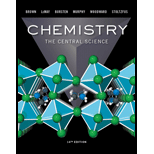
Study Guide for Chemistry: The Central Science
14th Edition
ISBN: 9780134554075
Author: Theodore E. Brown, H. Eugene LeMay, Bruce E. Bursten, Catherine Murphy, Patrick Woodward, Matthew E. Stoltzfus, James C. Hill
Publisher: PEARSON
expand_more
expand_more
format_list_bulleted
Concept explainers
Question
Chapter 24, Problem 86AE
(a)
Interpretation Introduction
To determine: The basic solution from the aqueous solution of the given compound.
(b)
Interpretation Introduction
To determine: The acidic solution from the aqueous solution of the given compound.
(c)
Interpretation Introduction
To determine: The most soluble solution from the aqueous solution of the given compound.
Expert Solution & Answer
Want to see the full answer?
Check out a sample textbook solution
Students have asked these similar questions
Explain the inductive effect (+I and -I) in benzene derivatives.
The inductive effect (+I and -I) in benzene derivatives, does it guide ortho, meta or para?
19.57 Using one of the reactions in this chapter, give the correct starting material (A-L)
needed to produce each structure (a-f). Name the type of reaction used.
(b)
ہ مرد
(d)
HO
(c)
དང་ ་་ཡིན་ད་དང་
(f)
HO
Br
B
D
of
oli
H
J
Br
K
C
人
↑
Chapter 24 Solutions
Study Guide for Chemistry: The Central Science
Ch. 24.2 - Prob. 24.1.1PECh. 24.2 - Prob. 24.1.2PECh. 24.2 - How many hydrogen atoms are in 2, 2-...Ch. 24.2 - Prob. 24.2.2PECh. 24.3 - Prob. 24.3.1PECh. 24.3 - Prob. 24.3.2PECh. 24.3 - Prob. 24.4.1PECh. 24.3 - Prob. 24.4.2PECh. 24.3 - Prob. 24.5.1PECh. 24.3 - Prob. 24.5.2PE
Ch. 24.4 - Prob. 24.6.1PECh. 24.4 - Prob. 24.6.2PECh. 24.7 - Prob. 24.7.1PECh. 24.7 - Practice Exercise 2 Name the dipeptide and give...Ch. 24.7 - How many chiral carbon atoms are there in the...Ch. 24.7 - Prob. 24.8.2PECh. 24 - Prob. 1DECh. 24 - Prob. 1ECh. 24 - Prob. 2ECh. 24 - Prob. 3ECh. 24 - Prob. 4ECh. 24 - Prob. 5ECh. 24 - Prob. 6ECh. 24 - Prob. 7ECh. 24 - Prob. 8ECh. 24 - Prob. 9ECh. 24 - Prob. 10ECh. 24 - Prob. 11ECh. 24 - Prob. 12ECh. 24 - Prob. 13ECh. 24 - Prob. 14ECh. 24 - Prob. 15ECh. 24 - Prob. 16ECh. 24 - Prob. 17ECh. 24 - Prob. 18ECh. 24 - Prob. 19ECh. 24 - Prob. 20ECh. 24 - Prob. 21ECh. 24 - Prob. 22ECh. 24 - Prob. 23ECh. 24 - Prob. 24ECh. 24 - Prob. 25ECh. 24 - Prob. 26ECh. 24 - Prob. 27ECh. 24 - Prob. 28ECh. 24 - Prob. 29ECh. 24 - Prob. 30ECh. 24 - Prob. 31ECh. 24 - Prob. 32ECh. 24 - Prob. 33ECh. 24 - Prob. 34ECh. 24 - Prob. 35ECh. 24 - Prob. 36ECh. 24 - Prob. 37ECh. 24 - Prob. 38ECh. 24 - Prob. 39ECh. 24 - Describe the intermediate that is thought to form...Ch. 24 - Prob. 41ECh. 24 - Prob. 42ECh. 24 - Prob. 43ECh. 24 - Prob. 44ECh. 24 - Prob. 45ECh. 24 - Prob. 46ECh. 24 - Prob. 47ECh. 24 - Prob. 48ECh. 24 - Prob. 49ECh. 24 - Prob. 50ECh. 24 - Prob. 51ECh. 24 - Prob. 52ECh. 24 - Prob. 53ECh. 24 - Prob. 54ECh. 24 - Prob. 55ECh. 24 - Prob. 56ECh. 24 - Prob. 57ECh. 24 - Prob. 58ECh. 24 - Prob. 59ECh. 24 - Prob. 60ECh. 24 - Prob. 61ECh. 24 - Prob. 62ECh. 24 - Prob. 63ECh. 24 - Prob. 64ECh. 24 - Prob. 65ECh. 24 - Prob. 66ECh. 24 - Prob. 67ECh. 24 - Prob. 68ECh. 24 - Prob. 69ECh. 24 - Prob. 70ECh. 24 - Prob. 71ECh. 24 - Prob. 72ECh. 24 - Prob. 73ECh. 24 - Prob. 74ECh. 24 - Prob. 75ECh. 24 - Prob. 76ECh. 24 - Prob. 77ECh. 24 - Prob. 78ECh. 24 - Prob. 79ECh. 24 - Prob. 80ECh. 24 - Prob. 81AECh. 24 - Prob. 82AECh. 24 - Prob. 83AECh. 24 - Prob. 84AECh. 24 - Prob. 85AECh. 24 - Prob. 86AECh. 24 - Prob. 87AECh. 24 - Prob. 88AECh. 24 - Prob. 89AECh. 24 - Prob. 90AECh. 24 - Prob. 91AECh. 24 - Prob. 92AECh. 24 - Prob. 93AECh. 24 - Prob. 94AECh. 24 - Prob. 95IECh. 24 - Prob. 96IECh. 24 - Prob. 97IECh. 24 - Prob. 98IECh. 24 - Prob. 99IECh. 24 - A typical amino acid with one amino group and one...Ch. 24 - Prob. 101IECh. 24 - Prob. 102IE
Knowledge Booster
Learn more about
Need a deep-dive on the concept behind this application? Look no further. Learn more about this topic, chemistry and related others by exploring similar questions and additional content below.Similar questions
arrow_back_ios
SEE MORE QUESTIONS
arrow_forward_ios
Recommended textbooks for you
 ChemistryChemistryISBN:9781305957404Author:Steven S. Zumdahl, Susan A. Zumdahl, Donald J. DeCostePublisher:Cengage Learning
ChemistryChemistryISBN:9781305957404Author:Steven S. Zumdahl, Susan A. Zumdahl, Donald J. DeCostePublisher:Cengage Learning ChemistryChemistryISBN:9781259911156Author:Raymond Chang Dr., Jason Overby ProfessorPublisher:McGraw-Hill Education
ChemistryChemistryISBN:9781259911156Author:Raymond Chang Dr., Jason Overby ProfessorPublisher:McGraw-Hill Education Principles of Instrumental AnalysisChemistryISBN:9781305577213Author:Douglas A. Skoog, F. James Holler, Stanley R. CrouchPublisher:Cengage Learning
Principles of Instrumental AnalysisChemistryISBN:9781305577213Author:Douglas A. Skoog, F. James Holler, Stanley R. CrouchPublisher:Cengage Learning Organic ChemistryChemistryISBN:9780078021558Author:Janice Gorzynski Smith Dr.Publisher:McGraw-Hill Education
Organic ChemistryChemistryISBN:9780078021558Author:Janice Gorzynski Smith Dr.Publisher:McGraw-Hill Education Chemistry: Principles and ReactionsChemistryISBN:9781305079373Author:William L. Masterton, Cecile N. HurleyPublisher:Cengage Learning
Chemistry: Principles and ReactionsChemistryISBN:9781305079373Author:William L. Masterton, Cecile N. HurleyPublisher:Cengage Learning Elementary Principles of Chemical Processes, Bind...ChemistryISBN:9781118431221Author:Richard M. Felder, Ronald W. Rousseau, Lisa G. BullardPublisher:WILEY
Elementary Principles of Chemical Processes, Bind...ChemistryISBN:9781118431221Author:Richard M. Felder, Ronald W. Rousseau, Lisa G. BullardPublisher:WILEY

Chemistry
Chemistry
ISBN:9781305957404
Author:Steven S. Zumdahl, Susan A. Zumdahl, Donald J. DeCoste
Publisher:Cengage Learning

Chemistry
Chemistry
ISBN:9781259911156
Author:Raymond Chang Dr., Jason Overby Professor
Publisher:McGraw-Hill Education

Principles of Instrumental Analysis
Chemistry
ISBN:9781305577213
Author:Douglas A. Skoog, F. James Holler, Stanley R. Crouch
Publisher:Cengage Learning

Organic Chemistry
Chemistry
ISBN:9780078021558
Author:Janice Gorzynski Smith Dr.
Publisher:McGraw-Hill Education

Chemistry: Principles and Reactions
Chemistry
ISBN:9781305079373
Author:William L. Masterton, Cecile N. Hurley
Publisher:Cengage Learning

Elementary Principles of Chemical Processes, Bind...
Chemistry
ISBN:9781118431221
Author:Richard M. Felder, Ronald W. Rousseau, Lisa G. Bullard
Publisher:WILEY
Lipids - Fatty Acids, Triglycerides, Phospholipids, Terpenes, Waxes, Eicosanoids; Author: The Organic Chemistry Tutor;https://www.youtube.com/watch?v=7dmoH5dAvpY;License: Standard YouTube License, CC-BY